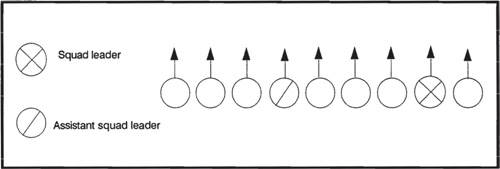
Movement formations include:
Column Formation
Column formations are used for deploying from one area to another when government forces are not present. When this move is performed by a squad, all members know their places in the formation. Positions are numbered in advance by the squad leader, and each numbered position is assigned a mission. Odd numbers are used for the left file of the column; and even numbers for the right file. The squad leader determines the spacing between personnel based on the terrain and visibility.
When required by terrain and operational needs, the squad leader divides the squad into two groups. The assistant squad leader takes the second group. This formation is normally used for movement over terrain where there is no probability of attack. The squad’s fire power is concentrated on the flanks; therefore, the point and rear are very weak. Figure 11-11 shows the column formation.

Figure 11-11. Column formation.
Single File or Firing Line Formation
This type of formation is used when necessary to cover a 100- to a 300-meter area. Figure 11-12 shows the single file or firing line formation. It is used when:

Figure 11-12. Single file or firing line formation.

Figure 11-13. Diamond formation.
Wedge Formation
A wedge formation is used for advancing or performing reconnaissance over open terrain. This formation covers the front, as well as both flanks; however, the rear is undefended. This type of formation is used mainly to move where there is a possibility of being attacked.
It can also be used to break or penetrate an enemy barrier. Figure 11-14 shows the wedge formation.

Figure 11-14. Wedge formation.
“L” Formation
The “L” formation is an attack formation used in two flanks. Figure 11-15 shows the “L” formation. It can be used before the assault by deploying one squad to gain a shock while the remaining squad provides security. From the formation of a single to a double column, it can quickly change to a diamond formation. These changes take place on command and are performed as discussed below.

Figure 11-15. L formation.
Double Column
Upon command, odd numbers extend to the left, while even numbers extend to the right. One combatant leads the formation at the front while the one at the rear provides rear security. Figure 11-16 shows a double column formation.
Changing Double Column to a Diamond Formation
In order to change a double column to a diamond formation, the insurgents change the above-mentioned formation. At this time, the insurgents on the right extend to that side, while those on the left extend to the right. (See Figure 11-16.) The combatant from the rear guard at the right flank maneuvers, while providing rear security. The group on the left that heads the team secures the front.

Figure 11-16. Double column formation.
Two-Echelon Formation
This type of formation is used for a deliberate attack or a movement to contact. While a squad advances, the other one supports it; upon occupying a new position, the one advancing stops and provides support while the other unit advances. Figure 11-17 shows two-echelon formation.

Figure 11-17. Two-echelon formation
Fan Formation
This formation is used when the commander calls the unit to assemble to assign a mission or issue other directives. The voice of command is: “SQUAD ASSEMBLE.” Figure 11-18 shows the fan formation.

Figure 11-18. Fan shape formation.